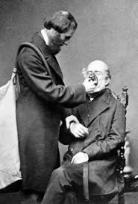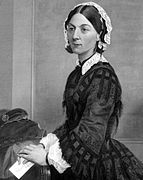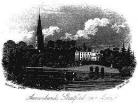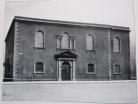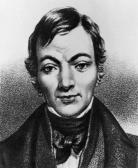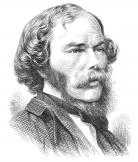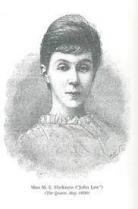Victorian Novels of Class, Gender, Race, and Empire Timeline
Created by Bettina Pedersen on Mon, 09/20/2021 - 13:16
This timeline will span that timeframe covered by the five Victorian novels included in our course and their authors.
Timeline
Chronological table
| Date | Event | Created by | Associated Places | ||
|---|---|---|---|---|---|
| circa. 1608 to circa. 1876 |
Britain in IndiaWhat began as the East India Company grew into Britain directly and indirectly controlling much of India. Britain began to expand its colonial settlements, brought in its own military and made alliances with Indian rulers. Britain had ignored their original claims to protect India and instead began to rule over the country. By 1876 Queen Victoria became Empress of India, and any rebellions were quickly dismantled. Many British people came to India for work, and once the job was finished they came back. The country was never fully settled by English people. In The Half-Caste, Zillah comes from India and is sent to live with the LePoer family although she is under the guardianship of Mr. Sunderland.
“The British Empire in the 19th Century | Máire Ní - Gale.” Gale A Cengage Company, Gale, Cengage Company, 2021, https://www.gale.com/intl/essays/maire-ni-fhlathuin-british-empire-ninet... |
Hope Tyler | |||
| Jul 1766 to 1777 |
Trent and Mersey Canal is BuiltThe Trent and Mersey Canal is a 93 ½ mile canal that connects the River Trent at Derwent Mouth in Derbyshire to the River Mersey which provides an inland route between the major ports of Hull and Liverpool. Construction began in 1766 and was completed in 1777. It provided cheap and reliable transport suitable for carrying delicates such as china as well has heavy goods like coal and clay. In the area called The Potteries in Stoke-on-Trent, where writer Dinah Mulock Craik (1826-1887) was born, were skilled manufacturers like Wedgewood, Minton, Adams, and Spode, so this combination of manufacturers and affordable reliable transport caused an industrial explosion. According to Hugh McKnight, who was popular for writing about canals and waterways, wrote that the population of the area grew from 7,000 in 1760 to 25,000 by 1800, and that just 61 years after that in 1861, the population grew even greater to about 120,000. Stoke-on-Trent was created a Parliament borough by the Reform Bill of 1832 with a right to send two members to Parliament. |
Charmen Atchison | |||
| circa. 1800 |
Medical Hierarchy in Late 1800'se class of doctors that commanded most prestige in 1800s was the physicians. They were not concerned with the external injuries, nor did they performed surgeries or set bones. Their work was mainly confined to check the pulse and urine of the patients. They were called the physicians because they only administered drugs or physic. They were chiefly concerned with giving of drugs to the patients that came to them. Physicians comprised of a handful of practicing doctors during the Victorian era. A chunk of them was located in London, where it was comparatively easy to find the chunk of the patient population and also the chances of making wealth and social status. To practice as a physician in London, a license from Royal College of Physicians was required. This was a mandatory requirement. During the Victorian era, there was no system of training by the medical schools. There were only a handful of hospitals that existed during the Victorian era. Many of the physicians believed that medicine ought to be taught by books and antiques. So even if there existed a large number of medical schools during the Victorian era, they wouldn’t have been successful. After the physicians, came the surgeons in the medical hierarchy. Their work was to perform surgeries, cut open the chest, deal with fractures and everything that a physician could not perform. The class of surgeons did not command that much respect from the society as the physicians did. Main reason for the same was that till 1745 they were formally linked with barbers and had to get bodies from the graveyard to learn how to perform surgeries. It was as a result of this difference in status, that the physicians were addressed as Dr. and surgeons as Mr. The last in the medical hierarchy were the apothecary. They were the lowest class in the medical hierarchy. They were the people who initially made the prescription form for the physicians but in the absence of the physicians, they also used to advise the patients. See |
Charmen Atchison | |||
| 1805 |
Mary Seacole's BirthMrs. Seacole was born Mary Jane Grant to a Scottish father and a Creole mother. She was born in Kingston, Jamaica in 1805, although she never revealed her full birthdate. She is one of three children and grew up in a relationship with her brother and sister. Her father was a Scottish soldier stationed in Jamaica which was a British colony. She grew up with her mother who taught her how to manage a home and care for the sick with herbal remedies. She began to help her mother in running the Grant boarding house and caring for the sick. She learned hard work and surviving on her own means from an early age, which she took with her throughout her life.
National Geographic Society. “Mary Seacole.” National Geographic, National Geographic Society, 15 Oct. 2012, https://www.nationalgeographic.org/article/mary-seacole/. Seacole, Mary. Wonderful Adventures of Mrs. Seacole in Many Lands, Penguin Classics. 1857. |
Hope Tyler | |||
| 21 Nov 1806 to 11 Apr 1814 |
Continental BlockadeEnacted by Napoleon, Emporer of France, an embargo was placed on England which restricted trade between them and the rest of the European continent. During this period, all connections to Britain were cut including mail services. After Napoleon's exile and the end of the Napoleonic wars, the embargo was lifted and British interaction with the continent could resume. In George Eliot's Middlemarch, the characters take advantage of the lifted embargo to travel to the continent and explore cultural sites. The Casaubons are able to travel to the Vatican and explore its art, which was formerly restricted.
“Continental System.” Wikipedia, Wikimedia Foundation, 15 Oct. 2021, https://en.wikipedia.org/wiki/Continental_System#:~:text=The%20embargo%2....  |
Anthony Calvez | |||
| 1807 |
Abolition of the Slave Trade ActBritian finally abolishes the slave trade in their empire and back home. There had been a very involved abolitionist movement in England, and the removal of slavery signaled a change in the way the world's most powerful empire dealt with human rights (https://www.nationalarchives.gov.uk/pathways/blackhistory/rights/aboliti...). Put into action only two years after Seacole was born, this act would have had explicit consequences on how she grew up and how she thought about slavery. On page 21, she describes how she "know[s] what slavery is; having seen with my eyes and heard with my ears proof positive enough of its horrors" (21). Seacole, Mary. Wonderful Adventures of Mrs. Seacole in Many Lands, Penguin Classics. 1857.
|
Emma McCoy | |||
| 1811 |
Elizabeth Gaskell Loses MotherAt just one year old, Elizabeth's mother died and she is taken to live in Knutsford, Chesire (only 20 minutes from Macclesfield) with her aunt Hannah Lumb, where she lived until the age of 20 when she went off to school. |
Charmen Atchison | |||
| 1813 |
Elements of Agricultural ChemistrySir Humphrey Davy was the author of Elements of Agricultural Chemistry that explored the use of electricity in agriculture. He was a natural philosopher, inventor, and minor poet. He was an English chemist who discovered elements such as potassium and sodium. He wrote the first text on chemistry in agriculture that was published and sold in 1813. The book was popular among farmers who learned to mass-produce in a new way.
Eliot, George. Middlemarch, edited by Gregory Maertz. 1874, Broadview Literary Texts. |
Hope Tyler | |||
| 1815 |
Apothecaries Act"An Act for better regulating the Practice of Apothecaries throughout England and Wales" is the official name of an Act of Parliament designed to regulate the training of apothecaries as medical professionals. While the effectiveness of the act is debatable, it was the first step by Parliament to attempt and have some regulation or standards of training for medical men.
AOP Cambridge Core. https://www.cambridge.org/core/services/aop-cambridge-core/content/view/....  |
Anthony Calvez | |||
| 1815 to 1815 |
Corn Law ActParliment passed this act to protect the landholders in England. It forbade the import of corn until domestic markets recovered. This lead to really high bread prices, and contributed to unrest among the lower classes. With food so expensive, people started to starve and began coming together to protest laws made against their interests. The law mostly benefited landowners because they were the ones growing corn. Because Parliament was composed mostly of landowners, they had no interest in repealing it. Ross, David "The Corn Laws" British Express, acc. 24 September 2021 |
Emma McCoy | |||
| The start of the month Summer 1815 |
The Apothecaries ActThis act focused on regulating the work of medical practitioners in England and Wales. This bill gave the government power to send out wardens to inspect shops and offices of dispensing chemists and surgeons. They examined the drugs they prescribed and imposed penalties when necessary. This reform, along with others exposed the possibility of the unrefined state of the medical profession and the stubbornness of medical men. Lydgate encounters this opposition when he comes to Middlemarch.
Eliot, George. Middlemarch, edited Gregory Maertz. Broadview editions 2004. |
Hope Tyler | |||
| circa. 1816 to circa. 1976 |
The Royal Infirmary for Woman and ChildrenThe hospital was founded in 1816 and was located on Waterloo Road. The hospital is similar to the one Nelly Ambrose takes her sick child. The hospital was designed to be a space for women and children to seek medical help. Many hospitals at the time would not accept children, so founder, Dr. John Bunnell Davis decided to take in any age of child including infants. The building had four stories with two wards for in-patients. The name of the hospital changed several times, but its mission to aid in the medical needs of women and children never did. In July 1976 the hospital officially closed. “Royal Waterloo Hospital for Children and Women.” Lost Hospitals of London, Webmaster, 30 Oct. 2021, https://ezitis.myzen.co.uk/royalwaterloo.html. Harkness, Margaret. A City Girl, edited Tabitha Sparks. Broadview editions 1887.
|
Hope Tyler | |||
| 24 May 1819 |
Birth of Queen VictoriaQueen Victoria was born May 24, 1819. She was Queen of England from 1837 to 1901 and until Elizabeth II, was the longest-reigning monarch in England. Her reign was notable for witnessing the rise of Industrial power in England, and the development of an urban society. Queen Victoria did not support women's suffrage or higher education but ironically she was an avid reader and privileged experience education and culture.
https://go-gale-com.pointloma.idm.oclc.org/ps/retrieve.do?tabID=T002&res...
|
Anthony Calvez | |||
| 22 Nov 1819 |
Birth of Mary Ann Evans (George Eliot)Mary Ann Evans who wrote under then pen name, George Eliot, was born at South Farm, Arbury, Warwickshire, on the 22 of November, 1819. She was born from her father's (Robert Evans) second marriage and she had two half-siblings and two full blooded siblings. Her mother (Christiana Pearson) had two more children, twin boys, but they died only 10 days after their birth. Evans then went to school in 1828 and went on to write several works including the novel, Middlemarch (1871-1872).
Wiesenfarth, Joseph. "George Eliot." Victorian Novelists Before 1885, edited by Ira Bruce Nadel and William E. Fredeman, Gale, 1983. Dictionary of Literary Biography Vol. 21. Gale Literature Resource Center, link.gale.com/apps/doc/H1200002772/LitRC?u=sand82993&sid=bookmark-LitRC&xid=e989404b. Accessed 26 Oct. 2021. |
Anthony Calvez | |||
| 12 May 1820 |
Birth of Florence NightingaleFlorence Nightingale was an English nurse who reinvented the profession of nursing during The Crimean War. She was born in Florence, Italy to British parents and became determined to become a nurse from a young age. Her parents spent many years trying to dissuade her from the profession but eventually in 1851 she found herself able to proceed in her career. Her reforms were crucial in her service in the Crimean War, primarily by improving the hygiene of soldiers and camps. Her work as a nurse creates an interesting contrast between her and the nursing of Mary Seacole. While both nurses went to Crimea as an act of goodwill to improve the lives and standings of officers, Nightingale's efforts are routed in a much more stoic place rather than one of profit. Despite their differences both women made essential efforts in helping soldiers and saving the lives of those in Crimea.
"Florence Nightingale." Gale Literature: Contemporary Authors, Gale, 2001. Gale Literature Resource Center, link.gale.com/apps/doc/H1000120985/LitRC?u=sand82993&sid=bookmark-LitRC&xid=060dd1a7. Accessed 9 Dec. 2021.
|
Anthony Calvez | |||
| 1821 |
Elizabeth (Gaskell) Stevenson Goes Off To SchoolElizabeth was sent to Miss Byerleys school in Barford Warwickshire in 1821 at the age of 20. Three years later, she, with her school, moved to Stratford-upon-Avon. This school later appeared in two of her novels, Lois the Witch, and My Lady Ludlow. https://gaskellblog.wordpress.com/2010/10/20/elizabethgaskell-bio/
|
Charmen Atchison | |||
| 1824 to 1824 |
Repeal of Combination ActThe original Combination Act of 1799 was repealed; groups could now meet for the purpose of improving working conditions. This was a major win for workers' rights and was a recognition of the condition of England. Given that Mary Barton was published in 1848, this opportunity for unions to form is pertinent to the novel. While controversial, the right to assemble as a worker was a landmark decision for humans rights. It represented a shift away from Parliament only defending the interests of the rich. Gaskell, Elizabeth Mary Barton edited Jennifer Foster. 1848, Broadview Literary Texts |
Emma McCoy | |||
| 20 Apr 1826 |
Birth of Dinah Mulock CraikBorn on April 20, 1826, Dinah Mulock Craik was an English poet and novelist. She was born at Stoke-on-Trent in Staffordshire, located between Manchester and London. She was an accomplished literary student, writing her first poem "The Party Of Cats" at ten years old, teaching Latin at her mother's school at thirteen years old and having her first published poem when she was sixteen. At twenty years old she took her mother and siblings to London where she supported her family financially with her literary work. Driven by the success of her poetry, Craik expanded into novel writing and wrote The Half-Caste as well as her most popular novel, John Halifax, Gentleman in 1856.
Colbeck, Mabel L., and Tirthankar Bose. "Dinah Maria (Mulock) Craik." Victorian Poets After 1850, edited by William E. Fredeman and Ira Bruce Nadel, Gale, 1985. Dictionary of Literary Biography Vol. 35. Gale Literature Resource Center, link.gale.com/apps/doc/H1200002651/LitRC?u=sand82993&sid=bookmark-LitRC&xid=6998955d. Accessed 4 Oct. 2021. |
Anthony Calvez | |||
| 1828 |
Intended Audience and William Gaskell’s CongregationI noticed an interesting connection between the image that Gaskel creates of the current status of the lower classes and the makeup of her husband's congregation and their treatment of the working class in the community directly surrounding Cross Street Unitarian Chapel in Manchester. The congregation at Cross Street was made up of philanthropic upper class gentlemen and gentlewomen: “William therefore came to a congregation with which many wealthy and powerful families were associated…, a congregation also of self made men deeply conscious of the need to improve the educational and social conditions of the working class from which they themselves had sprung” (Head). This was the kind of class of people that Gaskell especially wrote Mary Barton for, the people that were in a socioeconomic position to readily help those that needed it. It would make sense that there was some overlap between the intended audience for her book and the composition of her husband’s congregation. In Mary Barton, Gaskell points out that many of the suffering workers in Manchester were suspicious of the constituents of the upper classes, including ministers. This was due to the working class's horrible poverty during this time. This period of affliction resulted in a “feeling of alienation between the different classes.” Gaskell points out, I assume to the wealthy members of her husbands parish, that she knows–in a “Christian land” like England–the wealthily fortunate would have “thronged with their sympathy and their aid” if they were aware of the problems plaguing their community (Gaskell, 127). It makes sense that Mary Barton includes this last section in the passage to somewhat soften the hard knews of the upper classes' neglection of the lower class and remind them that the lower classes need the charity of those better off. Gaskell, Elizabeth. Mary Barton, edited Jennifer Foster. 1848, Broadview Literary Texts. Head, Geoffrey. “Cross Street Chapel in the Time of the Gaskells.” Cross Street Chapel:Individual Belief, Shared Community, 2009, https://cross-street-chapel.org.uk/cross-street-chapel-in-the-time-of-the-gaskells/. |
Brennan Ernst | |||
| 1829 |
The Roman Catholic Relief ActThis act was made to give civil rights to Roman Catholics and lifted any previous restrictions to voting or serving in the government. With that being said, Jesuit Priests still faced limitations on their voting rights because of the British government’s ongoing fear of them. Each Roman Catholic citizen had to swear allegiance to the King and be put under oath to be able to vote. In Middlemarch, many characters bring up Roman Catholicism and often debated differences in religion.
Eliot, George. Middlemarch, edited Gregory Maertz. Broadview editions 2004. |
Hope Tyler | |||
| 1830 to 1830 |
East Indians' Petition 1830The Eurasians were aware of their unequal status. They wanted respect, they asked for increased oppurtunties as civil servants in India. So in the year 1830, they decided to form a petiton in hopes to change things for the better, "In the petition, a majority of the educated Eurasians in Calcutta formally requested that they be granted full legal status as British subjects" (pg. 12). Unfortunatly this didn't help the Eurasians at all as the petition proved to be unsuccesful. However this did mark an era in which Eurasians fought for more oppurtuinites. Craik, Dinah Mulock The Half-Caste edited Melissa Edmundson. 1851, Broadview Literary Texts |
Jorge Sandoval | |||
| 1831 |
Dissolution of ParliamentAs we know, early in the story of Middlemarch, Dorothea Brooke's uncle Arthur Brooke, wanted to run for Parliament, which was essentially legistlative body of government. That was unfortunate for Mr. Brooke in the end, because he would end up doing badly in his performance for Parliament, he was also undecisive about the position in the first place. This was also prior to the Reform Bill of 1832, Parliament would end up being dissolved in the end by the year 1831, preventing anyone from actually receiveing the power. https://blogs.loc.gov/law/2017/09/middlemarch-and-the-rocky-road-to-the-... Eliot, George. Middlemarch, edited by Gregory Maertz. 1874, Broadview Literary Texts. |
Jorge Sandoval | |||
| 1831 to 1832 |
Baptist WarIt was mentioned in the chronology of Mrs. Seacole that in the year 1831, there was a Slave revolution in Jamaica. Naturally there was a slave trade back in the old days, but in 1807 the Slave Trade Act ended in Great Britan. Still, there were slaves in Jamaica, and they were tired of the way they were treated. They were lead by Samuel Sharpe, who inspired them to revolt. There were 14 white men who were dead and 217 rebels who died in the process. In the end, many were freed as they escaped with free lives, which would be fortunate because in th year 1833, a Partial abolition of Slavery in the colonies would be passed for them. Naturally since Jamaica was featured in the travel narrative, and slaves are seen there as well, it felt right to mention the moments when certain slaves had their freedom. Seacole, Mary. Wonderful Adventures of Mrs Seacole in Many Lands. Penguin Books, 2005. Pg. IX |
Jorge Sandoval | |||
| 1832 |
Reform Bill of 1832A footnote on page 373 of Middlemarch talks about the Reform bill of 1832, a bill sponsored by Lord John Russell. This bill intoruced huge changes to the electoral system in England because many found in unfair. It expanded the right to vote to more men and explicitly barred women from voting. The political changes in England mirror the political instability in Middlemarch. Eliot, George. Middlemarch, edited Gregory Maertz. Broadview editions 2004.
|
Emma McCoy | |||
| 1832 to 1865 |
Elizabeth marries William GaskellElizabeth Cleghorn Stevenson married William Gaskell in 1832. He was a junior minister at Cross Street Unitarian Chapel, Manchester. Together they had six children but only three survived. The couple remained busy for much of their lives because of her writing and his work as a minister. They were married for thirty-three years before her death. Gaskell, Elizabeth. Mary Barton edited Jennifer Foster. 1848, Broadview Literary Texts. |
Hope Tyler | |||
| 1833 |
First Still-Born BirthElizabeth Gaskell gave birth to a still-born daughter in 1833. As her first birth and pregnancy, Gaskell was devastated and reflected in writing during a period of depression following the birth. Gaskell had two more children die after birth later in her life. These experiences helped inform Gaskell's writing pertaining to the "fallen woman" trope presented in Mary Barton through the character Esther. Esther became pregnant out of wedlock and later kills her child that has become sick: "And I could not bear to see her suffer, and forgot how much better it would be for us to die together;—oh her moans, her moans, which money would give me the means of relieving! So I went out into the street, one January night—Do you think God will punish me for that?" (216). Esther could no longer care for the child and is forced to commit infantcide to her daughter. While this was not the case in Gaskell's life, the loss of a child is an impactful part of anyone's story--fiction or nonfiction.
Gaskell, Elizabeth. Mary Barton: A Tale of Manchester Life. Edited by Jennifer Foster, Broadview Literary Texts, 2000. |
Rachel Heckle | |||
| 1833 |
The new Factory ActThe Factory Acts were several attempts to improve working conditions without compromising profit for the middle and upper classes. In 1833, the act amended laws regarding child labor. It was made illegal for children under 9 to work in factories. Employers nended to have an age certificate for their child workers. Children of 9-13 years could work no more than nine hours a day. Children ages 13-18 years could work no more than 12 hours a day. Children could not work at night. Furthermore, children were required to have two hours of schooling each day and four factory inspectors were expected to enforce these guidelines. However, child abuse and exploitation did not end due to the act. In Mary Barton, we see the terrible conditions focused on the adults of the community, but also how the conditions of the home and work for the adults reflects back on the children at home. The Davenport family is the lowest working class family the reader experiences; however, the children of the Davenport family are remarked as "too young to work, but not too young to be cold and hungry" (97). The children of the working class are still neglected through the struggles and become a burden if they are too young to work. If they can work, the evidence of this act shows that the children may not be better off and could be exposed to more mistreatment, disease, and dangerous conditions.
Gaskell, Elizabeth. Mary Barton: A Tale of Manchester Life. Edited by Jennifer Foster, Broadview Literary Texts, 2000. “1833 Factory Act.” The National Archives, The National Archives, 23 Sept. 2021, https://www.nationalarchives.gov.uk/education/resources/1833-factory-act/. |
Rachel Heckle | |||
| 1834 to 1834 |
Poor Law Amendment ActThis law created a board of guardians for every parish as a way to get relief for the poor. However, poor people could only claim relief from the parish where they were born. We can see this in Mary Barton when the Davenports worry that the father won't get medical care because he has moved away from his home parish. While the intent behind the law was good, it effectively crippled people from getting their relief if they had moved away from home. Unrest continued between the classes, fueled by famine. Gaskell, Elizabeth Mary Barton edited Jennifer Foster. 1848, Broadview Literary Texts |
Emma McCoy | |||
| 1836 |
Mary Becomes Mrs. SeacoleMary Grant becomes Mary Seacole in 1836 and quickly becomes a widow, and never marries again. She keeps the name Seacole and writes and travels under the name. Although she had plenty of suitors, Mrs. Seacole decides to be an "unprotected woman" and travel the world without a man looking after her. Her marriage was something expected of her, but her widowed status gave her greater license to do what she wished. |
Emma McCoy | |||
| 1836 to 1844 |
Mary Grant marries Mr. SeacoleMary Grant married Edwin Horatio Seacole in 1836. They moved to Black River and opened a general store which was unsuccessful. While they were married, they traveled to the Bahamas, Haiti, and Cuba, where she furthered her studies in medicine. Mrs. Seacole explained that her husband’s health was often fragile, which led to his death in 1844. They were only married for eight years before he passed away, and they never had any children. In her will, he was identified as Viscount Nelson’s godson. Her life with him was loving and enjoyable, but in the end, she closed that chapter of her life and never remarried. Britannica, The Editors of Encyclopaedia. "Mary Seacole". Encyclopedia Britannica, 1 Jan. 2021, https://www.britannica.com/biography/Mary-Seacole. Accessed 13 October 2021. Seacole, Mary. Wonderful Adventures of Mrs. Seacole in Many Lands, Penguin Classics. 1857. |
Hope Tyler | |||
| 1837 to 1844 |
The Northern StarIn 1837 The Northern Star was founded by Feargus O'Connor, a chartist politician. He seeked to educate working class men and women about the ways in which the government should treat their people. This was a radical newspaper printed every week that provided credible information about the state of the working class and how Parliament was handling their affairs. The newspaper began in Leeds and remained until 1844 when it moved to London. At the time, the paper covered revolutionary ideals of the people who refused to settle with feeling unappreciated. The newspaper gained significant credibility of professionalism and remained successful during much of the Chartist movement. The Northern Star not only evaluated domestic politics and city life, but included British international affairs in order to keep their readers informed of the world around them. Because of O’Connor the newspaper was known for advocating for political reform, men's suffrage, and better working conditions. This newspaper is often read by John Barton in Elizabeth Gaskell's novel Mary Barton. He reads it as a way to learn about the Chartist movements within the country. Gaskell most likley wanted to add a resource in to give an explaination for John Barton's passion for the Chartism.
Vargo, Gregory. "'Outworks of the citadel of corruption': the Chartist press reports the empire." Victorian Studies, vol. 54, no. 2, Winter 2012, pp. 227+. Gale Literature Resource Center, link.gale.com/apps/doc/A293949956/LitRC?u=sand82993&sid=bookmark-LitRC&xid=4e1bbb6b. Accessed 3 Oct. 2021.
|
Hope Tyler | |||
| 1838 to 1839 |
The People's CharterThe People’s Charter was the first document published in 1838 to demand changes to the existing government for the benefit of the working class. Although it was primarily written by William Lovett, thousands of citizens signed the petition to demonstrate their support. The pamphlet proposed electoral reform, equality in Parliament, voting for men, vote by ballot, the abolishment of property qualifications for MPs as well as payment for MPs, and the adjustment of Parliament representative districts. The most encouraged proposal was the right to vote for men that were 21 years or older. They needed to be of sound mind with no criminal record. Before the Charter only a fraction of men were allowed to vote in the country so in this way more citizens would have a voice. Unfortunately, when the Charter was sent to Parliament, they rejected it. This caused civil unrest that rose and fell due to authorities. The proposal was published only a few years before Mary Barton so many characters are aware of the Chartist movement and the civil unrest embedded into the plot of the novel. Gaskell, Elizabeth Mary Barton edited Jennifer Foster. 1848, Broadview Literary Texts “The Chartist Movement.” UK Parliament, UK Parliament, 2021, https://www.parliament.uk/about/living-heritage/transformingsociety/elec.... |
Hope Tyler | |||
| circa. 1839 to circa. 1846 |
Hungry FortiesBritain had suffered an economic depression that lasted into what would be known as the "hungry forties". During this time, there was a period of strikes, widespread unemployment, poor harvests, and depressed trade. This was due to crop failures and thus this resulted in the deaths of many who starved. This was where the new type of genre was created for literature: the social problem novel. This was how Gaskell was able to publish Mary Barton, in relation to this developing trend in fiction. Indeed we can see this throughout the novel. We can see people who were unemployed and thus needed to work in order to get themselves back on their feet. Resources: Gaskell, Elizabeth Mary Barton edited Jennifer Foster. 1848, Broadview Literary Texts. "The British Library" https://www.bl.uk/romantics-and-victorians/articles/an-introduction-to-mary-barton |
Jorge Sandoval | |||
| 1840 |
Mary Ann Evans first publicationMary Ann Evan's finished her formal education five years prior to her first publication. She published a poem "As o'er the Fields," because she had recently been exposed to poetry, especially that of William Wordsworth. The poem was printed in January in the Christian Observer, a Presbyterian family newspaper. This first publication granted Mary Ann the support she needed to continue writing for the rest of her life.
Eliot, George. Middlemarch. edited Gregory Maertz. Broadview Editions. 2004 |
Hope Tyler | |||
| 1843 |
The Fire of 1843On August 26, 1843, a fire erupted in Kingston and burned down a tenth of the city. Valuable properties, homes, and businesses burned down. One of those homes was Mrs. Seacole’s which she mentions in her narrative. The cause of the fire remains unknown, but arson had been suspected which became a problematic suspicion. There had already been racial tensions, but the fire only made it worse. The city turned on the black population to blame them even though there had been no evidence to suspect such actions. About 10,149 Jamaican pounds had been distributed to those who lost property, although Mrs. Seacole never mentions receiving the money in her non-fiction narrative. By 1850 only a portion of the houses had been rebuilt. Lumsden, Joy. “1843 James the Founder's or Matcham's Fire.” Jamaica's History - Always Something New to Find out!, Weebly, 2018, https://jamaica-history.weebly.com/1843.html. Seacole, Mary. Wonderful Adventures of Mrs. Seacole in Many Lands, Penguin Classics. 1857. |
Hope Tyler | |||
| 1844 to 1844 |
The deaths of Mr. Seacole and his Mother in LawLosing a mother is always heartbreaking, just as much as losing your spouse, whom you've sworn to be with until death do them part. Naturally, Seacole was married to him in 1836, where they were happy until he grew ill. They initally had a store in Black River but they had to move to Mary's mother's house in Kingston, where Mary did the best she could to keep him alive but he died a month later, "This was my first great trouble, and I felt it bitterly" (Seacole. pg. 14). Naturally this was heartbreaking for her and some time after that she lost her mother, so she was left alone. She struggled at first but soon she learned to overcome her problems and move on with her life. It was from this sadness that Mary Seacole learned to work her way for her life, she became rich one day and then poor another day. Regardless, she would eventually gain the respect she deserved for her hard work, all because she had a tough beginning. Seacole, Mary. “Chapter I.” Wonderful Adventures of Mrs Seacole in Many Lands, Penguin Books, 2005, pp. 14. |
Jorge Sandoval | |||
| 1844 |
Mary Seacole and Her Refusal of Re-MarriageDespite the social norm of the time being that a woman is expected to marry a man in order to look upon him and depend upon him financially, Mary Seacole shatters this status quo by refusing to remarry after her first husband dies. It is stated in her book that “from a confidence in [her] own powers, and not at all from necessity, that [she] remained an unprotected female” (16). Despite many suitors coming to her home in Kingston once she became a widow, she never took any of them to be her betrothed. Refusing to remarry offered Seacole a sense of autonomy and agency that she would not have been awarded if she were married to a man. Because of this independence, she is able to fully step into the role of nurse and businesswoman. It is from these two professions that she was able to touch the lives of those around her.
Seacole, Mary. “Chapter II.” Wonderful Adventures of Mrs Seacole in Many Lands, Penguin Books, 2005, pp. 16. |
Brennan Ernst | |||
| 3 Oct 1845 |
Dinah Mulock Craik’s Mother DiesOn October 3, 1845, Craik's mother died, leaving Craik the primary caregiver and financial provider for herself and her two younger brothers. This event impacted her writing of The Half-Caste with the governess character of Miss Pryor. Miss Pryor's father passed away, leaving her as the primary financial source of her family as well
Craik, Dinah Mulock, and Melissa Edmundson. “Dinah Mulock Craik: A Brief Chronology.” The Half-Caste, edited by Melissa Edmundson, Broadview Editions, Peterborough, Ontario, Canada, 2016, pp. 39–41. |
Rachel Heckle | |||
| 1846 to 1860 |
1846–1860 Cholera PandemicThe Cholera outbreak was truly something that was featured heavily in Mrs. Seacole, as she worked hard to help people out as they were sick from it, "For a few days the terrible disease made such slow progress amongst us that we almost hoped it had passed on its way and spared us; but all at once it spread rapidly, and affrighted faces and cries of woe soon showed how fatally the destroyer was at work" (pg. 30). Indeed the Cholera outbreak was something horrible inded, many died to it and it was considered to have caused the largest amount of deaths in the 19th century. This indeed reminds me of our situation today with covid-19. “1846–1860 Cholera Pandemic.” Wikipedia, Wikimedia Foundation, 18 Nov. 2020, https://en.wikipedia.org/wiki/1846%E2%80%931860_cholera_pandemic Seacole, Mary. Wonderful Adventures of Mrs Seacole in Many Lands. Penguin Books, 2005.
|
Jorge Sandoval | |||
| circa. 1847 to circa. 1848 |
Typhus FeverThe typhus fever epidemic was rose in the nineteenth century and easily struck fear into communities. There were several epidemics that happened in this century and vaccines were not often found until much later. The typhus fever epidemic lasted from 1847-48 and killed thousands of people in Scotland, Ireland, and England. This happened just before Craik published The Half-Caste and is referenced by Cassandra Pryor when the LePoer family contracts the sickness.
Craik, Dinah Mulock. The Half-Caste, edited by Melissa Edmundson. Broadview Editions, 2016. |
Hope Tyler | |||
| 1848 to 1848 |
Communism and Robert OwenThe footnotes in the book are clear to point out that the Communism in Mary Barton is not the Communism of today. The largely negative connotations that readers from America have on Communism would not be present in Gaskell’s England. A large reason is because Mary Barton was published the same year that The Communist Manifesto was published and the manifesto was only released in German (Gaskell, edited by Foster). That means the Communism in the minds of Gaskell’s readers is not entirely the Communism of Marx and Engels. Despite this fact, the Communism of Gaskell’s time still advocated for socialist values and communal betterment. A leading proponent of Communism at the time was a factory owner named Robert Owen. Owen worked to better the working and living conditions of the lower class: some “described him as ‘the great pioneer’ in the fields of ‘rational education, factory legislation, trade unionism, cooperation, labour exchanges, work for the unemployed, the emancipation of women, penal reform and international peace’” (Robert Owen and his Legacy). Here in this description we can see the main tenets behind Marx and Engels hopeful vision of what the implementation of Communism can do in a community of the working class.
Gaskell, Elizabeth. Mary Barton, edited Jennifer Foster. 1848, Broadview Literary Texts
Robert Owen and his Legacy, edited by Chris Williams, and Noel Thompson, University of Wales Press, 2011. ProQuest Ebook Central, https://ebookcentral-proquest-com.pointloma.idm.oclc.org/lib/pointloma-e.... |
Brennan Ernst | |||
| 1848 |
Publication of Mary BartonIn 1848 Mary Barton was published. Originally titled John Barton, Gaskell was pursuaded to change the title when she was shown how the weight of the narrative rests on Mary. This condition of England novel made waves in the literary scene of England due to her compassion for the working class. Gaskell was born in Chelsea and after marriage moved to Manchester, where she was living when Mary Barton was published. Wikepedia |
Emma McCoy | |||
| 1849 |
Dinah Mulock Craik publishes The OgilviesIn 1849 Dinah Mulock Craik published The Ogilvies as her first published novel. This was not the first work she had ever published but the longest at the time. Previously she published work for magazines, journals, newspapers, and children’s books. This was significant because she established herself as a woman novelist. Her success only rose the more she wrote and she was acknowledged as a consistent writer and poet. When she was younger she was purposeful with her education as a woman author and her first published novel was an ode to the dedication she had committed to from an early age.
Craik, Dinah Mulock. The Half-Caste, edited by Melissa Edmundson. Broadview Editions, 2016. |
Hope Tyler | |||
| 1851 |
Dinah Mulock Craik publishes The Half Caste: An Old Governess's TaleDinah Mulock Craik publishes The Half-Caste: An Old Governess’s Tale. Craik published this novella in vol. 12 of Chamber’s Papers for the People in 1851. William and Robert Chamber’s published multiple volumes of Chamber’s Papers for the People and included Craik’s novella in a later edition. The novella has been edited and re-published several times. For this class we have read the1897 edition that had several major differences to the 1851 edition. Wikipedia Craik, Dinah Mulock. The Half-Caste, edited by Melissa Edmundson. Broadview Editions, 2016. |
Hope Tyler | |||
| 20 Apr 1851 to 12 Oct 1887 |
Dinah Mulock Craik (Accomplishments)Dinah Mulock Craik was one of the best-selling authors in the 19th century. She was even awarded a Civil List pension, which was one of the few awards given to a British writer. She published many essys, novels, and children's books throughout her life, thus providing an impact in the history of literature. It was by 1851 where she was able to publish The Half-Caste: An Old Governess's Tale, which was significant since it reflected what happened back then in the British Empire. The impact was that there were people of mixed races who struggled to find their role in the system that was placed then, their were treated horribly or were stripped of their culture in order to fit in with the times. Many memorials were paid in honor of Craik after her death, proving that her status as an author was worth noting. Alas, because she was the quintessential Victorian woman writer, her status as an author quickly passed from the public and so she was unfortunatly forgotten by many by the 20th century. Craik, Dinah Mulock. The Half-Caste, edited Melissa Edmundson. 1851, Broadview Literary Texts |
Jorge Sandoval | |||
| 1854 |
Eliot’s Rift With Family Over LewesEliot’s romantic life was less than orthodox for the time period she lived in; it was even unconventional for the 21st century. After she had moved to London and started working with the Westminster Review, she met an editor named George Henry Lewes in 1854 who eventually became her mentor and romantic companion. They lived as husband and wife even though Lewes was already married. Lewes was unable to divorce his previous wife because of religious restrictions. Of course, their relationship was considered sinful and morally wrong by a large part of society surrounding them. This relationship caused a rift between her and her brother, Isaac. This familial tie wasn’t reestablished until later on in their lives. Eliot worried that the nature of her relationship to Lewes might hurt her book sales, which is one of the many reasons she wrote under a male pseudonym. Atlas, Nava. “George Eliot, Author of Middlemarch.” Literary Ladies Guide, 12 July 2012, https://www.literaryladiesguide.com/author-biography/george-eliot/. |
Brennan Ernst | |||
| 28 Feb 1854 |
Birth of Margaret HarknessMargaret Elise Harkness was the second of five siblings. She grew up in a sheltered, religious, and conservative upper class household that was sheltered and religious. Her father was an Angelican priest of Irish origin while her mother was distantly related to English aristocracy. Indeed this was where Harkness originated from and she would travel a long road in order to become a writer.
|
Jorge Sandoval | |||
| 1855 |
Battle of the TchernayaThe Battle of the Tchernaya began with Russian troops initiating a bombardment on August 17, 1855, and did not ceasefire for ten days. On September 5 it was agreed to launch another final assault on the Malakoff. Three days later another renewed invasion happened at the Great Redan on September 8th. The battle was fought on the outskirts of Sevastapol. For the Russians, the plan was to drive the French out of the city. Unfortunately, the French allies gained a victory and forced the Russians to retreat after several days. Just before Mrs. Seacole becomes a nurse for the Crimean war, she mentions this battle that occurs before she gets to the war. Seacole, Mary. Wonderful Adventures of Mrs. Seacole in Many Lands, Penguin Classics. 1857. Brain, Jessica. “Timeline of the Crimean War.” Historic UK, Historic UK Ltd. Company, https://www.historic-uk.com/HistoryUK/HistoryofBritain/Timeline-Crimean-... |
Hope Tyler | |||
| 16 Aug 1855 |
The Battle of TchernayaThis battle was fought between the Russians and French, Sardinians, and Ottomans as a part of the Crimean War (1853-1856) and is recounted in "Chapter XVI" of Wonderful Adventures of Mrs Seacole in Many Lands. Within this chapter of Mary Seacole's travel log, Mrs Seacole is at the front treating the wounded on both sides of the war, witnessing tragic deaths: "...death is fearful indeed. It had to come peacefully enough to some. They lay with half-open eyes, and a quiet smile about the lips that showed their end to have been painless; others it had arrested in the heat of passion, and frozen on theit pallid faces a glare of hatred and defiance that made your warm blood run cold. But little time had we to think of the dead, whose business it was to see after the dying, who might yet to be saved" (142). This is a detailed event of the most impactful brush Mrs Seacole had with death and with the battles. She has seen death before, but not in this manner. Before, the readers witness slow deaths of people taken by disease in their own homes. In the Crimea, Mrs Seacole recounts the deaths of soldiers.
Seacole, Mary. “Chapter XVI.” Wonderful Adventures of Mrs Seacole in Many Lands, Penguin Books, 2005, pp. 134–144. |
Rachel Heckle | |||
| 1856 |
The Victoria Cross and The CrimeaDuring Seacole’s disclosing of her work with the wounded soldiers of the Crimean War, she notices such a medal resting on the breast of a soldier and comments on honor associated with receiving The Victorian Cross, which was and still is “the premier British award for conspicuous bravery in the face of an enemy” (207). It was instituted in early 1856–after the Crimean war had ended–in order to potentially be awarded to soldiers of all classes and ranks. Before this medal was created, officers could be recognized for their bravery by the Order of the Bath, an award founded by George I in 1725, but no such award existed for soldiers of a lower ranking, until Queen Victoria created her own medal. A total of 1,356 Victoria Crosses have been awarded since its inception 150 years ago. In its early years, Crosses were handed out more frequently than they are now. The most recent Cross was handed out to Private Johnson Beharry in Iraq in 2004.
Seacole, Mary. “Chapter XII.” Wonderful Adventures of Mrs Seacole in Many Lands, Penguin Books, 2005, pp. 207. Johnson, Ben. “The History of the Victoria Cross.” Historic UK, https://www.historic-uk.com/HistoryUK/HistoryofBritain/The-Victoria-Cross/. |
Brennan Ernst |


